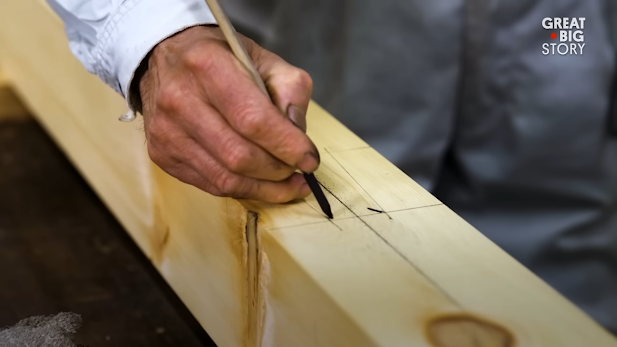Goosebump-Worthy Moment 2: Nail-less Carpentry by Takafumi Matsumoto
Fig. Japanese carpentry without a single nail. (Great Big Story)
https://www.youtube.com/watch?v=O-u4T13guko&t=27s&ab_channel=GreatBigStory
Takafumi Matsumoto is a
Miya Daiku, a shrine and temple carpenter who works in Kamakura, Japan.
Fig. Kamakura
https://www.youtube.com/watch?v=O-u4T13guko&t=27s&ab_channel=GreatBigStory
Fig. Kamakura, South West of Tokyo
Source: google earth modified by the author
Kamakura is located 50 km southwest of Tokyo and is abundant in natural beauty. It was the capital of Japan from the early 12th century to the mid-13th century. It was the site of the first government established by samurai under Shogun Minamoto Yoritomo. The feudal system lasted about 800 years until the Meiji Restoration in 1868.
Since Japanese shrines and temples are made of wood, they require restoration after a suitable number of years. For example, in wooden structures from 1,000 years ago, iron was hard to come by, so buildings were constructed by combining wood alone. To do this, each of the two parts to be joined was shaped with indentations and projections called 'tsugite' and 'kumite,' respectively, and then fitted together.
https://www.youtube.com/watch?v=O-u4T13guko&t=40s
Fig. Tsugite and Kumite. No nails.
https://www.youtube.com/watch?v=O-u4T13guko&t=27s&ab_channel=GreatBigStory
Wood develops defects in about 150 to 200 years. It can rot, break, or be affected by disasters. People in the past built structures with the anticipation that such times would come. Maintaining such a structure is the work of a miyadaiku (traditional Japanese carpenter).
In the scene starting at 1 minute and 35 seconds of this video, he brings two pieces of wood (tsugite and kumite) together and eventually taps them into place with his hands. Without using any nails, he creates intricate shapes in the wood and fits them together perfectly.
https://www.youtube.com/watch?v=O-u4T13guko&t=80s
The carpenter:
"After I graduated from
high school, I was a live-in apprentice
and learned the techniques of miyadaiku. By
learning these things, one can understand what Japanese people have done
throughout history."
"When I go to a shrine or a temple, I feel like serving them someway."
https://www.youtube.com/watch?v=O-u4T13guko&t=27s&ab_channel=GreatBigStory
My remarks:
1. I discovered something new for myself in this video. The voice of this person is smooth and feels soothing. Until I heard his voice, I hadn't realized that Japanese could have such a beautiful resonance.
2. He says
“When I go to a shrine or a temple, I feel like serving them someway.”
This seems to mean that for him, shrines and temples are
the same thing which is typical among the Japanese.













Comments
Post a Comment